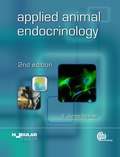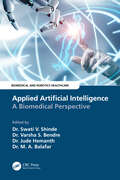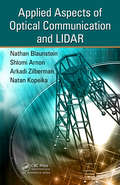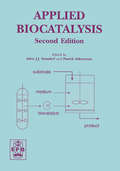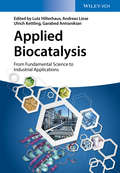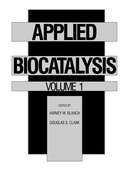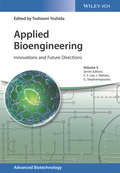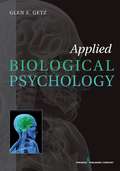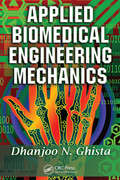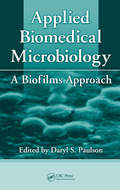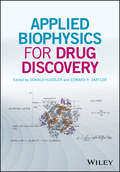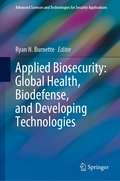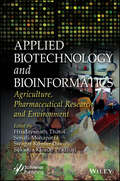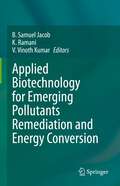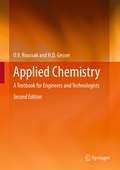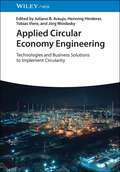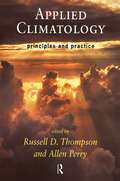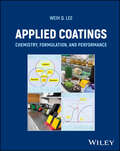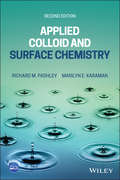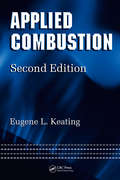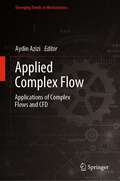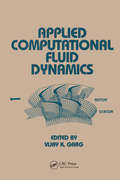- Table View
- List View
Applied Animal Endocrinology
by E. James SquiresThis textbook explains the role of hormones in improving and monitoring the production, performance, reproduction, behaviour and health of animals. With its focus on livestock animals: cattle, pigs, sheep and horses as well as poultry and fish; the book uses an integrative approach to cover endocrine concepts across species. This updated edition is expanded to include new topics in each section, with updated references, revised study questions and an expanded subject index. It is an essential text for students in animal and veterinary sciences as well as those in academia and industry that are interested in applications of endocrinology in animal production systems. Praise for the first edition: '...a useful text for teaching purposes and an important reference for those who seek ready access to information on specific aspects of applied endocrinology.' Poultry Science
Applied Artificial Intelligence: A Biomedical Perspective (Biomedical and Robotics Healthcare)
by Jude Hemanth Swati V. Shinde Varsha S. Bendre M. A. BalafarThis book explores the advancements and future challenges in biomedical application developments using breakthrough technologies like Artificial Intelligence (AI), Internet of Things (IoT), and Signal Processing. It will also contribute to biosensors and secure systems,and related research. Applied Artificial Intelligence: A Biomedical Perspective begins by detailing recent trends and challenges of applied artificial intelligence in biomedical systems.Part I of the book presents the technological background of the book in terms of applied artificial intelligence in the biomedical domain. Part II demonstrates the recent advancements in automated medical image analysis that have opened ample research opportunities in the applications of deep learning to different diseases. Part III focuses on the use of cyberphysical systems that facilitates computing anywhere by using medical IoT and biosensors and the numerous applications of this technology in the healthcare domain. Part IV describes the different signal processing applications in the healthcare domain. It also includes the prediction of some human diseases based on the inputs in signal format. Part V highlights the scope and applications of biosensors and security aspects of biomedical images.The book will be beneficial to the researchers, industry persons, faculty, and students working in biomedical applications of computer science and electronics engineering. It will also be a useful resource for teaching courses like AI/ML, medical IoT, signal processing, biomedical engineering, and medical image analysis.
Applied Aspects of Optical Communication and LIDAR
by Nathan Blaunstein Shlomi Arnon Natan Kopeika Arkadi ZilbermanExploring the practical aspects of atmospheric optical communication and light detection and ranging (LIDAR), Applied Aspects of Optical Communication and LIDAR details the role of atmospheric structures in propagation phenomena that influence the transmission of optical signals through perturbed atmospheric communication channels. It examines nume
Applied Biocatalysis
by Adrie J.J. Straathof Patrick AdlercreutzDescribing the essential steps in the development of biocatalytic processes from concept to completion, this carefully integrated text combines the fundamentals of biocatalysis with technological experience and in-depth commercial case studies. The book starts with an introductory look at the history and present scope of biocatalysis and proceeds t
Applied Biocatalysis: From Fundamental Science to Industrial Applications
by Garabed Antranikian Lutz Hilterhaus Ulrich Kettling Andreas LieseThis reference book originates from the interdisciplinary research cooperation between academia and industry. In three distinct parts, latest results from basic research on stable enzymes are explained and brought into context with possible industrial applications. Downstream processing technology as well as biocatalytic and biotechnological production processes from global players display the enormous potential of biocatalysts. Application of "extreme" reaction conditions (i.e. unconventional, such as high temperature, pressure, and pH value) - biocatalysts are normally used within a well defined process window - leads to novel synthetic effects. Both novel enzyme systems and the synthetic routes in which they can be applied are made accessible to the reader. In addition, the complementary innovative process technology under unconventional conditions is highlighted by latest examples from biotech industry.
Applied Biocatalysis: The Chemist's Enzyme Toolbox (Wiley Custom Select Ser.)
by John WhittallProvides clear and comprehensive coverage of recently developed applied biocatalysis for synthetic organic chemists with an emphasis to promote green chemistry in pharmaceutical and process chemistry This book aims to make biocatalysis more accessible to both academic and industrial synthetic organic chemists. It focuses on current topics within the applied industrial biocatalysis field and includes short but detailed experimental methods on timely novel biocatalytic transformations using new enzymes or new methodologies using known enzymes. The book also features reactions that are “expanding and making the enzyme toolbox available to chemists”—providing readers with comprehensive methodology and detailed key sourcing information of a wide range of enzymes. Chapters in Applied Biocatalysis: The Chemist’s Enzyme Toolkit are organized by reaction type and feature a short introductory section describing the current state of the art for each example. Much of the book focuses on processes for which the enzymes are readily available so that organic chemists can synthesize appropriate quantities of chemicals with available materials in a standard chemical laboratory. Advanced methods are included to present examples of new enzymes that might encourage collaboration with suppliers or academic groups and that will educate chemists of rapidly expanding future possibilities. Focuses on current topics within the applied industrial biocatalysis field Offers experimental methods on novel biocatalytic transformations using new enzymes or new methodology using known enzymes Covers the hot topics of enzyme and chemoenzymatic cascades and biocatalysis in flow Edited by noted experts from both academia and industry with years of experience in the field of biocatalysis—particularly, the industrial applications of enzymes Written for synthetic organic chemists working in all industries but especially the pharmaceutical industry and for those in academia with an eye for biocatalysis, Applied Biocatalysis: The Chemist’s Enzyme Toolkit will also benefit academic groups in chemistry and related sciences that are using enzymes for synthetic purposes, as well as those working in the area of enzymology and molecular biology.
Applied Biocatalysis: Volume 1
by Harvey W. Blanch; Douglas S. ClarkThis volume addresses the key topics: nonaqueous enzymology in general and protein design for organic solvents in particular, and enzymatic synthesis of carbon-carbon bonds, novel oligosaccharides, and modified steroids. It is a valuable source to experienced as well as potential users of enzymes.
Applied Bioengineering: Innovations and Future Directions
by Jens Nielsen Gregory Stephanopoulos Sang Yup Lee Toshiomi YoshidaA comprehensive overview of the topic, highlighting recent developments, ongoing research trends and future directions. Experts from Europe, Asia and the US cover five core areas of imminent importance to the food, feed, pharmaceutical and water treatment industries in terms of sustainable and innovative processing and production. In the field of enzyme engineering, they summarize historic developments and provide an overview of molecular enzyme engineering, while also discussing key principles of microbial process engineering, including chapters on process development and control. Further sections deal with animal and plant cell culture engineering. The final section of the book deals with environmental topics and highlights the application of bioengineering principles in waste treatment and the recovery of valuable resources. With its cutting-edge visions, extensive discussions and unique perspectives, this is a ready reference for biotechnologists, bioengineers, bioengineers, biotechnological institutes, and environmental chemists.
Applied Biological Psychology
by Glen E. GetzWritten for graduate students and trainees in mental health, this is the only text to present neurobiology in the context of clinical issues rather than merely focusing on experimental approaches to biological psychology or structuring it along neurological systems. In clear, easily accessible language the text explains how the brain and nervous system are linked to mental disorders. It integrates information from many aspects of neurobiological research, including imaging, neuropsychology, and genetics in order to foster an in-depth understanding of the psychiatric presentation of disorders that mental health professionals encounter in their practices. To facilitate student learning and clarify the connection between neurobiological foundations and clinical presentation, the text includes case studies, cognitive data, imaging results, genetic testing results, and illustrations. It examines major psychological disorders from behavioral, emotional, biological, cognitive and neurophysiological perspectives as they relate to brain structure and the major systems. Special topic sections highlight ethical, research, and treatment concerns for mental health practitioners. Each chapter concludes with summations and review questions. Written for graduate level students in clinical, counseling, and school psychology programs, the text fulfills APA accreditation requirements for coursework in the biological bases of behavior. While the text's primary aim is to help students understand neurobiological information as an important component of a therapeutic framework, it also concisely addresses micro and macro anatomy as relates to neurobiology.
Applied Biomedical Engineering Mechanics
by Dhanjoo GhistaPresenting the latest innovations, this text highlights advances in tissue, musculoskeletal, locomotive, orthopedic, occupational, ergonomic, sports, cardiovascular, cardiac, and pulmonary biomechanics. Based on years of teaching experience, the author uses illustrative examples and detailed explanations to show how mechanics disciplines can be applied to a wide range of clinical applications, including the analysis of physiological and organ-system processes; the creation of physiologically compatible organ-assist systems and devices; the performance of pre-surgical analysis in order to develop optimal surgical approaches; and the design of vehicle-occupant systems for occupant comfort.
Applied Biomedical Microbiology: A Biofilms Approach
by Daryl S. PaulsonFrom the slippery covering on rocks in a stream, to the clogging slime in a bathtub drain, biofilms are present in everyday life in a variety of forms. This seemingly harmless build-up also accounts for 80 percent of all microbial infections. With chapters authored by experienced contributors from academia and industry, Applied Biomedical Microbiol
Applied Biophysics for Drug Discovery
by Donald Huddler Edward E. ZartlerApplied Biophysics for Drug Discovery is a guide to new techniques and approaches to identifying and characterizing small molecules in early drug discovery. Biophysical methods are reasserting their utility in drug discovery and through a combination of the rise of fragment-based drug discovery and an increased focus on more nuanced characterisation of small molecule binding, these methods are playing an increasing role in discovery campaigns. This text emphasizes practical considerations for selecting and deploying core biophysical method, including but not limited to ITC, SPR, and both ligand-detected and protein-detected NMR. Topics covered include: • Design considerations in biophysical-based lead screening • Thermodynamic characterization of protein-compound interactions • Characterizing targets and screening reagents with HDX-MS • Microscale thermophoresis methods (MST) • Screening with Weak Affinity Chromatography • Methods to assess compound residence time • 1D-NMR methods for hit identification • Protein-based NMR methods for SAR development • Industry case studies integrating multiple biophysical methods This text is ideal for academic investigators and industry scientists planning hit characterization campaigns or designing and optimizing screening strategies.
Applied Biosecurity: Global Health, Biodefense, and Developing Technologies (Advanced Sciences and Technologies for Security Applications)
by Ryan N. BurnetteThis book describes an adaptable biothreat assessment process to complement overall biorisk management programs, incorporating threat management and the unique natures of biological assets. Further, this book examines the nexus between public health, international security, and developing technologies, building a case for augmenting biosecurity to levels beyond the laboratory constraints. With the face of biological and biomedical sciences changing, this book describes how with proper biosecurity development, these can become assets, rather than liabilities, to secure our world from natural and man-made biological disasters. The world is changing rapidly with respect to developing threats, such as terrorism, and dual-use technologies, such as synthetic biology, that are challenging how we think about biosafety and biosecurity. Further, the fields of public health and international security are colliding, as both of these share the common enemy: intentional or natural biological incidents. To date, biosecurity has been limited to laboratory-level application, and complicating efforts, and lacks credentialed biosecurity professionals skilled in both the biological sciences and threat management techniques. The result is a fragmented field of practice, with tremendous need, from the lab to the outbreak. Underpinning these principles is the SARS-CoV-2 coronavirus pandemic, providing a historic milestone to examine biosecurity through a global lens. This book describes biosecurity as a set of practices and principles to be augmented out of the constrained laboratory environment, and applied to larger efforts, such as international threat reduction and biological incident management.
Applied Biotechnology and Bioinformatics: Agriculture, Pharmaceutical Research and Environment
by Swagat Kumar Das Hrudayanath Thatoi Sonali Mohapatra Sukanta Kumar PradhanThis comprehensive reference book discusses the convergent and next-generation technologies for product-derived applications relevant to agriculture, pharmaceuticals, nutraceuticals, and the environment. The field of modern biotechnology is a multidisciplinary and groundbreaking area of biology that includes several cutting-edge methods due to developments in forensics and molecular modeling. Bioinformatics is a full-fledged multidisciplinary field that combines advances in computer and information technology. Numerous applications of bioinformatics—primarily in the areas of gene and protein identification, structural and functional prediction, drug development and design, folding of genes and proteins and their complexity, vaccine design, and organism identification—have contributed to the advancement of biotechnology. Biotechnology is also essential to crop improvement in agriculture because it allows genes to transfer across plants to increase traits such as disease resistance and yield. It also plays a broad role in healthcare, including genetic testing, gene therapy, pharmacogenomics, and drug development. Bioremediation and biodegradation, using microbial technologies to clean up environmental contamination, waste management technologies, and the conversion of organic waste to biofuels. Bioinformatics plays a critical role in analyzing different types of data created by high-throughput research methods—such as genomic, transcriptomic, and proteomic datasets—that are useful in addressing various problems related to disease management, clean environment, alternative energy sources, agricultural productivity, and more. Audience The book will interest biotechnology researchers and bioinformatics professionals working in the areas of applied biotechnology, bioengineering, biomedical sciences, microbiology, agriculture and environmental sciences.
Applied Biotechnology for Emerging Pollutants Remediation and Energy Conversion
by B. Samuel Jacob K. Ramani V. Vinoth KumarThis contributed volume comprises of detailed chapters covering the biotechnological approaches employed for the removal of toxic recalcitrant xenobiotics such as petroleum hydrocarbons, textile dyes, microplastics and synthetic polymers that pose serious threat to the environment. It also includes the waste to energy conversion strategies that provides a deep insight on the need for waste circular economy for different developing countries and its implication on sustainable development goals such as SDG 12 (responsible consumption and production) SDG 14 (Life below water); and SDG 15 (Life on land). Emerging pollutants sourced from both industries and anthropogenic activity have created havoc in recent years for public health and destruction of biodiversity at multiple levels. The alarming increase in the global population and rapid industrialization might aggravate the problems associated with these hazardous pollutants in near future. Effluent from different industries may contain high amounts of xenobiotic hazardous contaminants such as dyes, hydrocarbons, synthetic surfactants, microplastics, etc. Industries and public sewers handling such waste streams are facing a plethora of challenges in the effluent treatment and solid waste disposal due to various factors that start from production to adoption of appropriate technologies. Therefore, there is an immediate circumvention of bottlenecks through sustainable mitigation strategies. This book is of interest to teachers, researchers, climate change scientists, capacity builders and policymakers. Also, the book serves as additional reading material for undergraduate and graduate students of agriculture, forestry, ecology, soil science, and environmental sciences. National and international agricultural scientists, policy makers also find this to be a useful read.
Applied Chemistry: A Textbook for Engineers and Technologists
by Oleg Roussak H. D. GesserThe second edition of Gesser's classic Applied Chemistry includes updated versions of the original 16 chapters plus two new chapters on semiconductors and nanotechnology. This textbook introduces chemistry students to the applications of their field to engineering design and function across a wide range of subjects, from fuels and polymers to electrochemistry and water treatment. Each chapter concludes with a reading list of relevant books and articles as well as a set of exercises which include problems that extend the topics beyond the text. Other supplements to the text include a laboratory section with step-by-step experiments and a solutions manual for instructors.
Applied Chemoinformatics: Achievements and Future Opportunities
by Thomas Engel Johann GasteigerEdited by world-famous pioneers in chemoinformatics, this is a clearly structured and applications-oriented approach to the topic, providing up-to-date and focused information on the wide range of applications in this exciting field.The authors explain methods and software tools, such that the reader will not only learn the basics but also how to use the different software packages available. Experts describe applications in such different fields as structure-spectra correlations, virtual screening, prediction of active sites, library design, the prediction of the properties of chemicals, the development of new cosmetics products, quality control in food, the design of new materials with improved properties, toxicity modeling, assessment of the risk of chemicals, and the control of chemical processes.The book is aimed at advanced students as well as lectures but also at scientists that want to learn how chemoinformatics could assist them in solving their daily scientific tasks.Together with the corresponding textbook Chemoinformatics - Basic Concepts and Methods (ISBN 9783527331093) on the fundamentals of chemoinformatics readers will have a comprehensive overview of the field.
Applied Circular Economy Engineering: Technologies and Business Solutions to Implement Circularity
by Tobias Viere Juliano B. Araujo Henning Hinderer Jörg WoidaskyAn essential resource for circular economy engineering as a business sustainability solution and risk mitigation measure In Applied Circular Economy Engineering: Technologies and Business Solutions to Implement Circularity, a team of distinguished researchers delivers an up-to-date discussion of the implementation of circular economy concepts in industrial practice. It examines a comprehensive range of solutions and ideas from engineering and business research from the perspective of the European Circular Economy Package. The book explores the most relevant material and product flows, including metals, polymers, and food, as well as common product lifecycle steps, like product design, material extraction, and recycling. Applied Circular Economy Engineering explains the most effective applied practices, business considerations, and forward-looking solutions to frequently experienced business problems. Readers will also find: A thorough introduction to how circular economy considerations influence process design, product design, energy, and waste managementReal-world case studies of circular design and processesPractical discussions of a wide variety of industries adopting circular economy principles, including medical devices and foodComplete treatments of circular economy implementation and challenges, including business circularity maturity assessments and transition plans Perfect for chemical and process engineers, Applied Circular Economy Engineering: Technologies and Business Solutions to Implement Circularity will also benefit business economists, product planners, and anyone else involved in the engineering and development of circular products or processes.
Applied Climatology: Principles and Practice
by Allen Perry Dr Russell Thompson Russell Thompson'Big freeze' conditions, storms, severe flooding, droughts, and heatwaves - recent extremes in weather, with their resultant physical, economic and human losses, highlight the vulnerability of society to changes in the atmosphere. Atmospheric pollution, urbanization, natural atmospheric disasters are causing dramatic changes in climatic environments.Applied Climatology examines the effects of climate on physical, biological and cultural environments. Specialist contributors from Europe, North America and Australasia examine the impacts of changing climates on the functioning and development of physical biological environments including glaciers, water resources, landforms, soils, vegetation and animals.Weather and climate effects day-to-day activities and lifestyles from the clothes we wear to the buildings we design, and the food and energy we produce. This book focusses on the relationship between climate and a wide range of human activities and responses relating to health and comfort, building design, transport systems, agriculture and fisheries, tourism and social, industrial and legal issues.Climate-environment relationships and impacts on human activities are predicted to change dramatically if global warming accelerates at the rates currently proposed. Applied Climatology examines the characteristics and consequences of the changing global climate and considers the future for both natural and human environments.
Applied Coatings: Chemistry, Formulation, and Performance
by Weih Q. LeeAPPLIED COATINGS An integrated collection of case studies providing a concise guide for professionals working with coatings materials in academia and industry In Applied Coatings: Chemistry, Formulation, and Performance, distinguished scientist Dr. Weih Q. Lee delivers an illuminating collection of case studies designed to connect various elements of applied coatings technology. Going beyond generic discussions, the author describes the fundamental chemistry, formulations, and properties of applied coating materials – including the structural and functional components of structure-property relationships – as well as the foundations of applied cure kinetics and the rheology of epoxy coatings. Each chapter is self-contained, comprehensive, and can be read individually, while the book remains technically and editorially integrated. Core themes include structure-performance relationships, formulation index driven experiment design, and consolidated thermal analysis. Readers will also find: A thorough introduction to epoxies and epoxy curing agents, including oxetanes, vinyl esters, glycidyl methacrylate (GMA), isocyanate and silicone crosslinkers, cationic catalysts, acrylate and phenol accelerators, and specialty derivatives Attentive descriptions of epoxy curing chemistry, including epoxy-phenolic, -polyamide, -active ester, and acid- or base-catalyzed systems in a broader scope Comprehensive explorations of cure kinetics and rheology, including model-free kinetics (MFK), the nth-order model covering Kissinger plots and the Borchardt—Daniels (BD) approach, the autocatalytic model, executive quantification via curve fitting of DSC (differential scanning calorimetry) exotherms, the rheology of non-reactive fluids, and the viscoelasticity of reactive coatings Practical discussions of C1S thick-film surface coatings, C2S structural lamination, liquid and powder epoxies, and phenolic coatings, including fluorene monomers, heterocyclic resins, and polymerizable derivatives Complete treatments of coating characterization, microencapsulation, epoxy hybrids and non-epoxy platforms, adhesion of applied coatings, and adhesion promotion, including reactive and functional silicones Perfect for formulation and research and development scientists and engineers at any technical level, Applied Coatings will also benefit research professors and students studying coatings, adhesives, composites, electronic materials, and more.
Applied Colloid and Surface Chemistry
by Richard M. Pashley Marilyn E. KaramanAn updated guide to the interaction between solids, liquids, and gases and their application to numerous everyday processes The revised and updated second edition of Applied Colloid and Surface Chemistry offers a comprehensive introduction to this interdisciplinary field that takes a practical approach and includes information on applications drawn from a wide range of industries. The easy-to-follow text contains new content that focuses on applications such as the prevention of propeller cavitation, industrial explosives, PFAS contamination, and bubble column evaporators. With contributions from noted experts on the topic, the book contains keynote sections written by practicing industrial research scientists, who highlight real-world industrial examples. These examples range from water treatment through to soil management as well as examples from the coatings and photographic industries. Designed as an accessible resource, the book separates the more demanding mathematical derivations from the main text. The text features approachable, structured chapters, learning objectives, tutorial questions with answers, and explanatory notes. This important book: Offers a combination of physicochemical background, industrial, and everyday applications and experiments Underlines the importance of colloidal sciences in science and industry Presents real-world industrial applications Includes tried and tested laboratory experiments Written for students of chemistry, materials science, and engineering, Applied Colloid and Surface Chemistry, Second Edition offers an updated guide to soft matter presenting the bridge between science, with proven laboratory experiments, and real-world industrial applications.
Applied Combustion (Mechanical Engineering)
by Eugene L. KeatingThe second edition of this practical text offers a broad introduction to the engineering principles of chemical energy conversion. Eugene L. Keating, Ph.D., P.E., a recognized authority within academia, government, and industry, examines combustion science and technology using fundamental principles. Thermochemical engineering data and design formu
Applied Complex Flow: Applications of Complex Flows and CFD (Emerging Trends in Mechatronics)
by Aydin AziziThis book presents improved numerical techniques and applied computer-aided simulations as a part of emerging trends in mechatronics in all areas related to complex fluids, with particular focus on using a combination of modeling, theory, and simulation to study systems that are complex due to the rheology of fluids (i.e., ceramic pastes, polymer solutions and melts, colloidal suspensions, emulsions, foams, micro-/nanofluids, etc.) and multiphysics phenomena in which the interactions of various effects (thermal, chemical, electric, magnetic, or mechanical) lead to complex dynamics. The areas of applications span materials processing, manufacturing, and biology.
Applied Computational Aerodynamics
by Russell M. Cummings William H. Mason Scott A. Morton David R. Mcdaniel Russell M. Cummings William H. Mason Scott A. MortonThis computational aerodynamics textbook is written at the undergraduate level, based on years of teaching focused on developing the engineering skills required to become an intelligent user of aerodynamic codes. This is done by taking advantage of CA codes that are now available and doing projects to learn the basic numerical and aerodynamic concepts required. This book includes a number of unique features to make studying computational aerodynamics more enjoyable. These include: • The computer programs used in the book's projects are all open source and accessible to students and practicing engineers alike on the book's website, www. cambridge. org/aerodynamics. The site includes access to images, movies, programs, and more • The computational aerodynamics concepts are given relevance by CA Concept Boxes integrated into the chapters to provide realistic asides to the concepts • Readers can see fluids in motion with the Flow Visualization Boxes carefully integrated into the text.
Applied Computational Fluid Dynamics
by Vijay K. Garg"Describes the latest techniques and real-life applications of computational fluid dynamics (CFD) and heat transfer in aeronautics, materials processing and manufacturing, electronic cooling, and environmental control. Includes new material from experienced researchers in the field. Complete with detailed equations for fluid flow and heat transfer.
